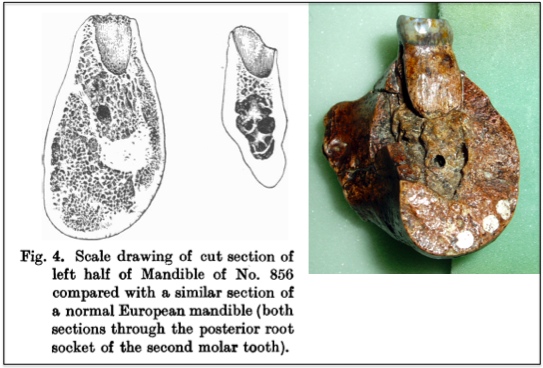Every once in a while google scholar leads me to something intriguingly bizarre. Attempting to find literature on some mandibular anatomical minutia, I came across this 1924 paper from the Journal of Anatomy on “an abnormal skull from New Guinea.” The paper ended up providing no insight in what I was attempting to find, but did include a few interesting pictures and sketches of the “abnormal skull” in question.

What I was really struck by was this sketch drawing of a cut cross-section of the jaw just distal to the second molar.

The specimen on the right side of the image is Sangiran 6, an enigmatic Homo erectus specimen found in Java in the 1940s. I say “enigmatic” because Sangiran 6 was one of the specimens first identified as “Meganthropus,” a taxon not generally accepted today. In reality the specimen bears many affinities to Homo erectus, though the proportions of its jaw, particularly the shape of its corpus, make it fairly exceptional. In looking at lots of fossil mandibles and mandibles of recent humans and non-human primates, I don’t think I’ve ever seen a specimen superficially remind me so much of Sangiran 6 as the “abnormal skull” in question. The authors do not attempt to identify what sort of pathology the specimen is afflicted by, although they do note some similarities with leontiasis ossea.
Another fun quirk to the article is that the authors discuss the fraudulent “Piltdown” specimen within their comparisons, noting the lack of human-like characteristics in its external features (hmm…wonder why that is…).
******
1. J. Ekblem Gullberg and A. N. Burkitt, An Abnormal Skull from New Guinea, with Remarks on the Structure of the Mandible. Journal of Anatomy, 1924; October; 59(Pt 1): 41–55.
